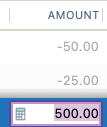Editing the opening balance
If you choose to reconcile using a paper statement, Quicken will show you a Starting Balance (also known as a Prior Balance). The balance shown is the result of all reconciled transactions and, as long as you didn't change a reconcile transaction, will equal the ending balance of your last reconciliation. Normally, you will not change the number that Quicken puts here. However, you can change this number if you feel the need.
What happens when the opening balance is changed?
When you change the starting balance, Quicken will insert an adjustment transaction at the end of the reconcile process such that the register balance is adjusted by the amount of the change. For example:
- Suppose that Quicken computes a stating balance of $100.
- You change the starting balance to $125.
- At the end of the reconcile process, an adjustment for $25 will be inserted in the register, increasing the balance by $25 as you indicated by your change.
As described earlier, Quicken will offer to insert ending balance adjustments when you can't balance. Here are explanations of how the starting balance adjustment works with all the possible cases:
- If the sum of the reconciled transactions plus the cleared transactions, but not including the starting adjustment, does not equal the ending balance, then the starting balance adjustment will be inserted and an ending balance will also be inserted if it is needed to total to the ending balance. However, an ending balance adjustment that is zero will not be inserted.
- If the sum of the reconciled transactions plus the cleared transactions happens to equal the ending balance (very unlikely given that you changed the starting balance but possible) then the starting balance adjustment is not inserted because, if it were, there would have to be an ending balance that completely negates the starting balance in order to equal the ending balance.
How to edit the opening balance
- Select the account on your sidebar.
- Find the entry for the Opening Balance balance in your register. It should be the very earliest entry.

- Double-click on the Amount column for the entry.
- Enter a new starting balance under Amount.

- Press the Return key.
The Opening Balance is now updated.
Examples
Here are some examples of when or why you might change the starting balance.
Example 1
- You have many transactions that go back several years.
- You don't want to go back and fix up your transaction history.
- The bank statement for the month of July just arrived.
- You start the reconcile process and you can account for all the transactions in July.
- But because your transaction history before July is not in good order, the sum of reconciled transactions in the history is unlikely to match your true balance at the beginning of July. Let's say the starting balance at the start of July is $5,000 but the sum of all reconciled transactions is only $1,000.
- Because you can account for all transactions for the month of July, you would normally not need an ending balance. But because you are $4,000 off at the start, you would need a $4,000 ending adjustment for the end of July.
- If you change the starting balance to match the bank statement, then you will get a starting balance adjustment for $4,000 and no ending balance adjustment for July. The starting balance adjustment has a different payee than an ending balance adjustment and documents that this adjustment is a special case.
Example 2
- You created a new Quicken account but didn't add an opening balance. Say the account had $2,000 in the bank.
- You get the next bank statement, which shows a beginning balance of $2,000.
- When you reconcile, the sum of all reconciled transactions is $0 because you haven't reconciled before.
- So even if you can account for all the transactions for the month, you would get an ending balance adjustment of $2,000.
- But if you change the starting balance adjustment to $2,000, then you would only get a starting balance adjustment, which is a clue that something different from a failure to balance has occurred.
- This is admittedly a strained example because the more logical way to fix this problem is to enter the missing opening balance adjustment.
